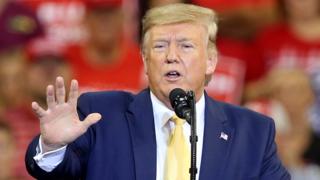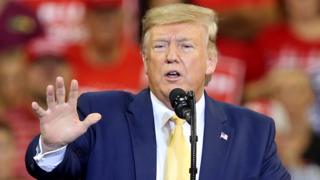Tensions highlight the importance of global trade
High profile trade rows simply underline the value and importance to us all of global trade. …

 Image copyright Getty Images
Image copyright Getty Images Global trade used to be a slightly worthy topic – loved by economists and confined to the financial pages of newspapers.
But recent high profile trade rows have changed all that, underlining its value and importance to us all.
Looking at the news headlines, it is easy to think that trade flows are going into reverse. The continuing dispute between the US and China has seen Washington imposing tariffs on more than $360bn (£287m) of Chinese goods, while Beijing has retaliated with tariffs on more than $110bn of US products.
Elsewhere, Japan and South Korea’s trade dispute is threatening the production of smartphones, computers and other electronics, while the European Union and the UK face potential disruption from a disorderly Brexit.
Yet step back from the headlines, and take the longer view, and things look different. The world traded more than $25tn in goods and services in 2018 – and that’s more than 50 times the value of the products directly affected by the US and Chinese tariffs.
The growth in global trade may have slowed to 3.0% this year – the lowest since the 2009 recession – according to International Monetary Fund, but the trend is still upward
The more a country trades with its neighbours, the better the state of its economy; and nations whose domestic economies are growing significantly also tend to have higher rates of growth in trade as a share of their output, argue economists.
“Liberal trade policies that allow the unrestricted flow of goods and services sharpen competition, motivate innovation and breed success,” says the World Trade Organization (WTO).
And trade has existed as long as we humans have formed civilised societies. In the 3rd millennium BC, the Sumerian city states in Mesopotamia (now Iraq) traded with the Harappan civilization of the Indus Valley (present-day Pakistan, parts of India and Afghanistan).
By the 2nd millennium BC, Bronze Age Greece, Egypt, Babylon and the Hittite empire (now Turkey) regularly traded with each other – and with distant Afghanistan, where the semi-precious stone, lapis lazuli, was highly prized for its intense blue colour and used in jewellery.
It was a trade that came to a spectacular end when their interconnected civilisations came crashing down around 1150BC – perhaps the first example we know of a “global” economic collapse.
Today the sheer variety of global trade can be astounding. For example, take cut flower exports from countries like Peru and Kenya. These have soared thanks to the growth of air travel, and the trade is now worth more than $16bn a year – that’s a lot of bouquets.
Or take the humble bicycle; in the UK 50 years ago most were produced in one city – Nottingham. Today the industry is worth $45bn worldwide, and relies on an integrated global supply chain with “rims from Bulgaria, titanium from China, metal from Taiwan, hub gears from America”, says Will Butler-Adams of the UK’s Brompton Bikes firm.
But it is the 20th Century’s semiconductor chip which has gone further than any other single item of technology in deepening many of our connections. It’s estimated the average western customer now uses services from 40 satellites orbiting the globe every day – all thanks to computer chips.
While silicon – the natural element at the heart of this $500bn industry – is found in 90% of the Earth’s crust, much of it comes from just one small town in North Carolina called Spruce Pine. A particularly pure source of quartz, the mineral from which silicon is extracted, is mined there.
“It does boggle the mind a bit,” says mine manager Rolf Pippert, “to consider that inside nearly every cell phone, and computer chip, you’ll find quartz from Spruce Pine.”
In modern history, there have been two long waves of globalization. The first started after the Napoleonic wars in 1815 and ended with World War One. The second started after 1945 and is still continuing; the volume of goods exported today is more than 40 times greater than it was in 1913, with about 25% of total global production sold abroad.
Now we are seeing another radical shift.
While it took centuries for the world’s economies to shift from agriculture to manufacturing, the rise of the services sector has occurred much more quickly over the past 20 years, and now accounts for 68% of total global GDP.
Yet here, barriers to trading services internationally still remain, putting a break on economic growth.
“What good is it manufacturing world-class goods if you don’t have sufficient access to business services like banking, accountancy and insurance to make global operations viable?” argues Simon MacAdam, global economist at Capital Economics.
Global Trade
More from the BBC’s series taking an international perspective on trade:
When it comes to exporting, small and medium-sized businesses (SMEs) are often under-represented. Bigger firms have more capacity to absorb the expense of pioneering in new overseas markets, and smaller firms can often find it hard to get the relevant information they need in a timely fashion.
But recent changes in the global trading landscape, such as the rise of global value chains and the digital transformation, are offering new opportunities for SMEs to integrate into the global economy.
Greater flexibility and capacity to customise and differentiate products can give SMEs a competitive advantage in global markets, as they can respond rapidly to changing market conditions and increasingly shorter product life cycles.
So what next? The opening decades of the 21st Century have been labelled as heralding an “Asian century”. While critics might quote those oft-disputed words of Zhou Enlai – “it is too soon to say” – what is certainly true is that established trading patterns have radically changed.
We’ve seen the rise of new groupings like Brics (Brazil, Russia, India, China, South Africa), and new trade deals like the Comprehensive and Progressive Agreement for Trans-Pacific Partnership (CPTPP): agreed between Australia, Brunei, Canada, Chile, Japan, Malaysia, Mexico, New Zealand, Peru, Singapore, and Vietnam, the CPTPP is now the world’s third-largest free trade area.
The only two still bigger are the North American Free Trade Agreement between the US, Canada and Mexico; and the European Union.
Advocates of free trade say that while globalisation is causing political strains in some countries, as employment patterns shift, retreating into simple protectionism will simply exacerbate rather than resolve problems.
And on that note, in her summary earlier this month, IMF chief economist Gita Gopinath pointedly referred to the global importance of calming the current trade disputes.
“To rejuvenate growth, policymakers must undo the trade barriers put in place with durable agreements, rein in geopolitical tensions and reduce domestic policy uncertainty.”
In the end, it all comes down to trade.
- Follow Tim Bowler on Twitter@timbowlerbbc
You can watch the latest Made on Earth film at these times this weekend on BBC World TV: Sat 26 Oct at 01:30 and 08:30 GMT; Sun 27 at 14:30 and 21:30 GMT. Click here for more programme information.



